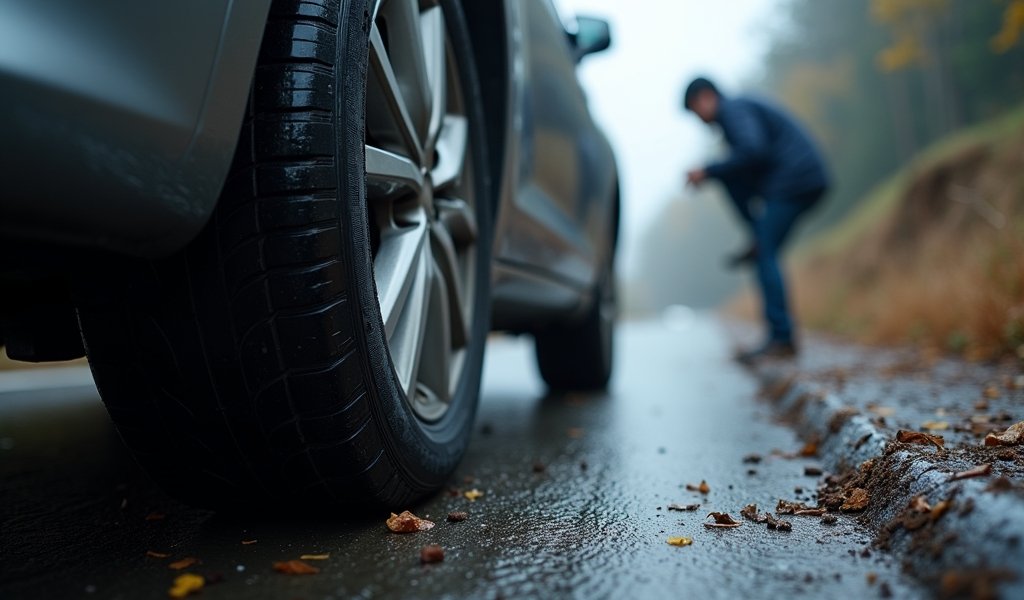Overview
Car tires typically last 25,000-50,000 miles (3-5 years), though lifespan varies based on tire quality, driving habits, maintenance practices, and environmental conditions. Regular maintenance—including proper inflation, rotation, balancing, and alignment—can significantly extend tire life, while driving habits like hard acceleration, braking, and cornering can dramatically reduce it.
Table of Contents
- Understanding Tire Lifespan
- Factors Affecting Tire Life
- Signs Your Tires Need Replacement
- Essential Tire Maintenance Tips
- Seasonal Tire Considerations
- Tire Rotation and Balancing
- How Driving Habits Impact Tire Life
- Conclusion
- Frequently Asked Questions
Understanding Tire Lifespan
As a mechanic with over 15 years in the shop, I’ve seen countless drivers shocked when I tell them their tires are worn out. “But I just bought these two years ago!” they exclaim. The truth about how long car tires last isn’t as straightforward as many expect. Most passenger vehicle tires typically last between 25,000 to 50,000 miles or roughly 3 to 5 years of average driving.
However, these numbers aren’t set in stone. I’ve seen high-quality tires with proper maintenance reach 70,000 miles, while others barely make it to 20,000. The lifespan depends on numerous factors – from how you drive to where you drive and even what you drive.
Even if you barely drive, rubber compounds in tires naturally degrade over time. Exposure to oxygen and UV rays causes a chemical process called oxidation that gradually hardens rubber and creates those tiny cracks you might notice on older tires. This is why most manufacturers recommend replacing tires after 6-10 years regardless of tread depth.
Factors Affecting Tire Life
The lifespan of your tires isn’t just about mileage. Several key factors determine how quickly they wear:
- Tire quality and design – Premium tires generally last longer than budget options
- Road conditions – Rough roads accelerate wear dramatically
- Climate – Extreme temperatures (hot or cold) can speed up deterioration
- Driving style – Aggressive driving is brutal on tires
- Maintenance habits – Proper inflation and rotation schedules matter enormously
- Vehicle weight and type – Heavier vehicles put more stress on tires
The type of tire also matters significantly. All-season tires typically last longer than high-performance summer tires, which sacrifice longevity for grip. Similarly, choosing seasonal-specific tires might mean more upfront cost but can extend overall tire life by using each set only when conditions are appropriate.
Vehicle alignment plays a crucial role too. A car with poor alignment can wear through tires astonishingly quickly – I’ve seen extreme cases where misalignment caused tires to wear out in less than 10,000 miles. According to Tire Rack’s technical research, even minor alignment issues can reduce tire life by 20% or more.

Signs Your Tires Need Replacement
Don’t wait until you’re stranded roadside with a flat to check your tires. Here are telltale signs that replacement time is approaching:
Tread Depth
The most reliable indicator is tread depth. New tires typically start with about 10/32″ to 11/32″ of tread (around 8-9mm). When they reach 2/32″ (1.6mm), they’re legally worn out in most states. You can measure this with an inexpensive tread depth gauge or use the penny test – insert a penny with Lincoln’s head upside down into the tread groove; if you can see all of Lincoln’s head, your tires need replacement immediately.
Visual Indicators
Modern tires include built-in tread wear indicators – small raised bars at the bottom of the tread grooves that become flush with the tread when worn to 2/32″. When you start seeing these bars across multiple grooves, it’s shopping time.
Also watch for these warning signs:
- Cracks or splits in the sidewall
- Bulges or blisters on the tire surface
- Uneven wear patterns (could indicate alignment or suspension issues)
- Excessive vibration while driving
- Age – check the DOT code on the sidewall (last four digits show manufacture week/year)
Just yesterday, a customer came in complaining about poor traction in light rain. One look at his tires showed severe cupping wear – a wavy pattern across the tread surface. His suspension needed work, but he’d been ignoring the symptoms until his tires became dangerous.
Essential Tire Maintenance Tips
If you want your tires to reach their full potential lifespan, these seven maintenance tips are non-negotiable:
1. Maintain Proper Inflation
This is the single most important factor in tire longevity. Check pressure monthly (including your spare) and before long trips. Under-inflation is the leading cause of premature tire failure and can reduce tire life by up to 25% according to NHTSA research.
Don’t guess the pressure – check your vehicle’s door jamb sticker or owner’s manual for the correct PSI. And remember, the number on the tire sidewall is the maximum pressure, not the recommended one.
2. Rotate Regularly
Different positions on your vehicle wear tires differently. Front tires on front-wheel-drive vehicles typically wear faster on the outside edges due to turning forces. Rotating every 5,000-7,000 miles helps even out these wear patterns.
The proper rotation pattern depends on your vehicle’s drivetrain type, but your mechanic should know the right approach. This simple service can extend tire life by thousands of miles.
3. Check Alignment Annually
Even minor misalignment can cause dramatic tire wear. Have your alignment checked annually or after hitting significant potholes or curbs. Many shops offer free alignment checks – take advantage of this service when getting oil changes.
4. Balance When Needed
Unbalanced tires create vibration that not only wears tires unevenly but can damage suspension components. Have tires balanced when mounted and rebalanced if you notice vibration developing at certain speeds.
5. Inspect Regularly
Take a minute each month to visually inspect your tires. Look for embedded objects, unusual wear patterns, and damage to sidewalls. Catching issues early can prevent more severe problems later.
6. Maintain Your Suspension
Worn shocks, struts, or other suspension components put additional stress on tires. Address suspension issues promptly to avoid accelerated tire wear.
7. Consider Tire Age
Even with plenty of tread remaining, tires should generally be replaced after 6-10 years due to rubber degradation. The U.S. Tire Manufacturers Association recommends professional inspection after five years and replacement after ten years regardless of tread depth.
A comprehensive maintenance schedule by mileage should include these tire care tasks to maximize not just tire life but overall vehicle performance and safety.
Seasonal Tire Considerations
Living in areas with distinct seasons presents unique challenges for tire longevity. If you experience both hot summers and snowy winters, consider these specialized approaches:
Dedicated Winter Tires
Winter tires are designed with special rubber compounds that stay flexible in cold temperatures and tread patterns that excel in snow and ice. While they cost more upfront, using winter tires during cold months and all-season or summer tires during warm months means each set wears only half the year, potentially doubling their calendar lifespan.
I’ve had customers who’ve gotten 8+ years from a set of winter tires by using them only 4-5 months annually. That’s smart tire management.
Proper Storage
When storing seasonal tires, keep them in a cool, dry place away from direct sunlight and ozone sources (like electric motors). Consider using tire bags or covers, and either stack them flat or hang them from tire racks. Never store tires directly on petroleum-based products like oil or gasoline, which can degrade rubber.
Seasonal Pressure Adjustments
Tire pressure drops about 1 PSI for every 10°F decrease in temperature. This means tires properly inflated during summer months may be significantly underinflated by winter. Check pressure more frequently during seasonal transitions.

Tire Rotation and Balancing
Let me shed some light on two often misunderstood services that significantly extend tire life: rotation and balancing.
Rotation Patterns Matter
Different vehicles require different rotation patterns:
- Front-wheel drive: Front tires move to the rear in same position, rear tires move to the front but switch sides
- Rear-wheel drive: Rear tires move to the front in same position, front tires move to the rear but switch sides
- All-wheel drive: Often use a cross-rotation pattern
- Directional tires: Can only be rotated front-to-back on the same side
Using the wrong pattern negates many benefits of rotation. Your technician should know the right pattern for your vehicle, but it never hurts to check your owner’s manual to confirm.
Balancing Isn’t Just for Comfort
Many drivers think balancing is just about eliminating vibration – and it does do that – but it’s also crucial for even tire wear. An unbalanced tire creates uneven pressure distribution that accelerates tread wear in specific areas.
Modern computerized balancing equipment can detect imbalances of less than a quarter ounce! This precision matters for both comfort and longevity.
For the best results, have tires balanced:
- When first installed
- During each rotation service
- When you notice vibration
- After repairing a tire
Combining regular rotation with proper balancing can easily add 5,000-10,000 miles to your tire life. That’s a small service cost for a significant extension in tire lifespan.
How Driving Habits Impact Tire Life
Your right foot has more influence on tire lifespan than almost any other factor. I’ve seen identical vehicles with the same tires show dramatically different wear rates based solely on how they’re driven.
The Hard Costs of Hard Driving
Aggressive acceleration creates excessive slippage between tires and road, literally grinding away tread rubber. Hard braking produces similar effects while creating flat spots and uneven wear patterns.
High-speed cornering generates tremendous lateral forces on tires, stressing sidewalls and accelerating shoulder wear. One track day can wear tires more than a month of normal driving!
Speed and Temperature
Higher speeds generate more heat in your tires. Heat accelerates rubber breakdown and can even change the molecular structure of the compounds. This is why performance driving instructors often recommend letting tires cool down between hard runs.
Improving Your Technique
Small changes in driving habits yield big improvements in tire life:
- Accelerate gradually from stops
- Anticipate stops to avoid hard braking
- Take corners at moderate speeds
- Maintain reasonable highway speeds
- Avoid unnecessary idling (creates flat spots)
- Dodge potholes and road hazards when safe
One customer of mine extended his tire life by over 20,000 miles simply by changing his driving style after we discussed how his habits were affecting wear. He’d been replacing tires every 25,000 miles but now routinely gets 45,000+ from the exact same brand and model.
If you’re considering choosing the right tires for your car, remember that even the most expensive, highest-rated tires will disappoint if subjected to aggressive driving.
Conclusion
The question “how long do car tires last?” doesn’t have a single answer – it depends on a constellation of factors, many within your control. With proper maintenance and reasonable driving habits, most quality tires can deliver 40,000+ miles of safe service.
The financial motivation for tire care is compelling. A set of quality tires can cost $600-$1,200 or more. Extending their life by even 25% represents significant savings, not to mention the improved fuel efficiency properly maintained tires provide.
But the most important reason to care for your tires isn’t financial – it’s safety. Tires with adequate tread depth and proper inflation respond better in emergency situations, maintain traction in adverse conditions, and provide the handling characteristics your vehicle was designed to deliver.
Don’t wait until you’re sliding in the rain or feeling every bump in the road to think about tire care. Start implementing these maintenance practices today, and you’ll enjoy safer driving, better performance, and yes – longer-lasting tires.
Remember, your tires are the only parts of your vehicle that actually touch the road. Take care of them, and they’ll take care of you.
Frequently Asked Questions
How can I check my tire’s age?
Look for the DOT code on the sidewall – the last four digits indicate the manufacturing week and year. For example, “3421” means the 34th week of 2021.
Should I replace all four tires at once?
Ideally, yes, especially for AWD vehicles to prevent differential damage. At minimum, replace tires in pairs on the same axle.
Can I mix different tire brands or models?
It’s not recommended as different tires have different handling characteristics and tread patterns. Stick with identical tires when possible.
How often should I check tire pressure?
Check pressure monthly and before long trips. Temperature changes affect pressure significantly, so more frequent checks during seasonal transitions are wise.
Are expensive tires worth the extra cost?
Often yes, as premium tires typically last longer and perform better in various conditions. The cost difference is usually offset by extended lifespan and improved safety.

